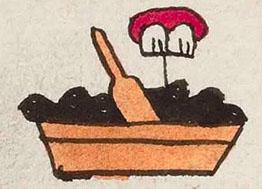Oxitlan (Mdz46r)
This compound glyph stands for the place name Oxitlan. It features a ceramic bowl of oxitl, a resinous liquid used in herbal remedies. The substance is in a bowl (xicalli) with a serving implement. Both the bowl and the serving implement are terracotta colored. The oxitl is black and appears to be in lumps. The xicalli has a thin black line running horizontally across the trapezoidal container. The locative suffix (-tlan) is represented by two white front teeth with red gums (tlantli), which offer only the phonetic, not the semantic, value.
Stephanie Wood
The locative suffix -tlan (near), does not specify abundance the way the suffix -tla (or -tlah, including the glottal stop), does. The gloss clearly shows the final "n" on the locative.
Stephanie Wood
oxitlan/puo
Oxitlan, pueblo
Stephanie Wood
c. 1541, but by 1553 at the latest
Stephanie Wood
medicines, remedies, medicinas, resins, pomades, unguents, resinas, ungüentos, pomadas, nombres de lugares

oxi(tl), turpentine unguent or resin, https://nahuatl.wired-humanities.org/content/oxitl
-tlan (locative suffix), https://nahuatl.wired-humanities.org/content/tlan
"By the Unguent" (Whittaker, 2021, p. 67); "Where Oxitl Abounds" (Berdan and Anawalt, 1992, p. 197)
OXI—tlan (2021, 67)
Codex Mendoza, folio 46 recto, https://digital.bodleian.ox.ac.uk/objects/2fea788e-2aa2-4f08-b6d9-648c00..., image 102 of 188.
The Bodleian Libraries, University of Oxford, hold the original manuscript, the MS. Arch. Selden. A. 1. This image is published here under the UK Creative Commons, “Attribution-NonCommercial-ShareAlike 3.0 License” (CC-BY-NC-SA 3.0).




